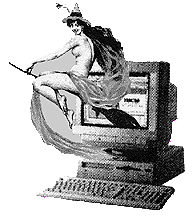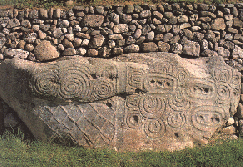To![]()
![]()

The Craft of the Wise is otherwise known as "Witchcraft"- a word that still frightens some religious "authorities". Christian missionaries often still misinterpret it to mean a worker of harmful magic or "a person who works with the devil to do magic", but such ideas come from time when anything that was spiritually powerful but not authorised by the Church was seen as getting its power from the devil.Miracles were then what God did, Magic was what the devil did. Thus even medieval healers who were not sanctioned by the church were killed as witches.
Today the word "witch" has been reclaimed in Western societies by many who believe in working closely with nature and in recognising the female aspect of the deity. It is mostly based on ways of developing one's natural powers.
The Craft teaches us to find our Creatrix and Creator within us. God and Goddess for me are two aspects of the one Divinity. Unlike most modern religions, the Craft fully honours the female as well as the male aspects.It uses myth, poetry and stories. Different aspects of the divinity may be given different names. All that is natural is seen as good. Only actions that harm others are forbidden.
In practice it is not institutional. The Craft is learnt by people working alone or in small groups called "families", "circles" or "covens." It does not need expensive churches. Instead a temporary sacred space can be set up anywhere as needed by using symbols. There is no professional clergy governing a flock of laity. All are expected to learn how to write and work rituals to celebrate what they find most sacred. All effectively become priestesses or priests.
The practice of nature centred magic developed out of many hunter-gather cultures that honoured and used those with great spiritual knowledge and skills as spiritual leaders, "dreamers" or shamans. This practice was also very individualistic. In Roman times "witches" were sometimes persecuted by members of the official pre-Christian religions perhaps because they were seen as being outside the establishment.
Prior to the rise of Christianity, witches were linked to the worship of Diana in Italy - where there is reportedly a continuous history of witchcraft or "strega". Many church documents record that from the early medieval period witchcraft was a commen practice among the British population. It was seen by some as a relic of old pagan practices - but it was also practiced by some Christians.
"Pagans" comes from "pagani", a Latin word meaning country folk. "Heathen" meant the people of the heath - where stood the ancient burial mounds and stone circles. These became words used by city folk to describe the people of the earth, of the countryside and of old religious ways.
When in Europe there arose a powerful Church-State institution under the control of an exclusively male priesthood, the stage was set for the persecution of those thought still to practice the old ways. As these practices were not authorised by the Churches, they were seen as a religious threat. Powerful women were particularly seen as a threat to the patriarchy that ruled the Churches. Once Europe had been "Christianised", it was seen as a duty of a "subject" to be a member of the authorised Church. If one stood outside this church, one was therefore a heretic, a traitor and perhaps also a witch if suspected of unauthorised prayers or curses (spells) or cures (magic). It was a civil crime to be a heretic and thus the suspects were often condemned to death by civil courts.
It seems that many of those traumatised and/or killed were accused simply because they were suspected of not being members of the ruling church (Protestants sought witches in Catholic areas, Catholics in Protestant areas). But some of those killed claimed that they owed a higher allegiance to the Deity than they owed to the Churches. Some refused to answer the questions of their inquisitors. Some used shamanic and imaginative language in their replies. Many were victims of a theology that saw the devil as the inspirer of all religious dissent, the one who gave "magic" its effectiveness and the one whose influence had to be driven out by any means including brutal torture. Many were simply the victims of fear, especially that felt by men towards women who were suspected of having a hidden power especially over male sexuality.
This fear was not altogether unfounded. Women did it seems sometimes use what was known as knot magic to try to lessen the power of men over them. This was through focussing the will, telepathy, whatever one had, towards secretly influencing another's actions - using a knot tied in cloth as a tool or focus for this energy. Women were said to use this to protect themselves from "lovers" they did not want.
This fear of female power went back to the teachings of the Fathers of the Church in the 3rd-5th Centuries. St Augustine was highly influenced by the Stoics, a fashionable philosophical school of that time. This taught that in order to achieve perfection one had to place one's reason in firm control over all ones actions. Augustine concentrated - and achieved firm rational control over all his body motions - excepting those of one organ! He wrote in some dismay about this. He explained it by using the Garden of Eden myth. God had given men a disobedient organ to remind them of the Fall!
But how could it then be explained that a pretty woman had power to move this organ when she passed by? Again the Garden of Eden myth came to the rescue. She was allied to the Serpent, the Devil,and the Devil gave her this power over the male disobedient organ! Thus was developed the theology that was to cause the deaths of thousands of women from soon after the rise of Christianity. (eg. Hypatia was accused of being a witch before being brutally murdered in Alexandria - she was seen as a rival to the local Bishop) . It should not be forgotten that today, in Africa and in Saudi Arabia, people are still being killed for being witches.
In the mid 1400s Pope Innocent
Third ![]() commissioned a report on witchcraft
from two Dominican priests. The resulting book, "Malleus
Mallificarum", also known as "The Hammer of the Witches", attacked
witches for such crimes as turning men's male members into the
likeness of animals and for robbing men of their virility. This
frightening book of irrational male phobias was backed by Papal
Authority and thus respected by many as "the voice of God". It used
in the persecution, torture and murder of many many thousands of
women and of many men for several centuries. The Christian image of
the devil became that of Pan, the pagan God of the wilderness.
Centuries of persecution and killings thus drove underground the
those with alternative religious views and a sense of nature as not
"fallen" but sacred. There was no room in this Europe for any open
practice of old shamanic religious traditions.
commissioned a report on witchcraft
from two Dominican priests. The resulting book, "Malleus
Mallificarum", also known as "The Hammer of the Witches", attacked
witches for such crimes as turning men's male members into the
likeness of animals and for robbing men of their virility. This
frightening book of irrational male phobias was backed by Papal
Authority and thus respected by many as "the voice of God". It used
in the persecution, torture and murder of many many thousands of
women and of many men for several centuries. The Christian image of
the devil became that of Pan, the pagan God of the wilderness.
Centuries of persecution and killings thus drove underground the
those with alternative religious views and a sense of nature as not
"fallen" but sacred. There was no room in this Europe for any open
practice of old shamanic religious traditions.
Some of those who are embracing the Craft today even say that it was the teachings of Christ that led them to it - for some find the modern Craft with its emphasis on love, on the goodness of nature, as more true to Christ's teachings than are the Churches. But the major influences on them and on many among my friends seems to be simply that of instinct, of love of nature and perhaps of old memories. Some practice as solitaries, others in covens. Others have found the Craft through the revival known as Wicca which currently commonly uses variants of rituals composed by men and women in the 1950s - such as Gerald Gardner and Dorleen Valiente who in their turn drew from the experiences of others. A more spontaneous Craft ritual making is taught in books such as "The Spiral Dance" by Starhawk.
![]()

![]()
![]() Click to return to the Library Entrance.
Click to return to the Library Entrance.